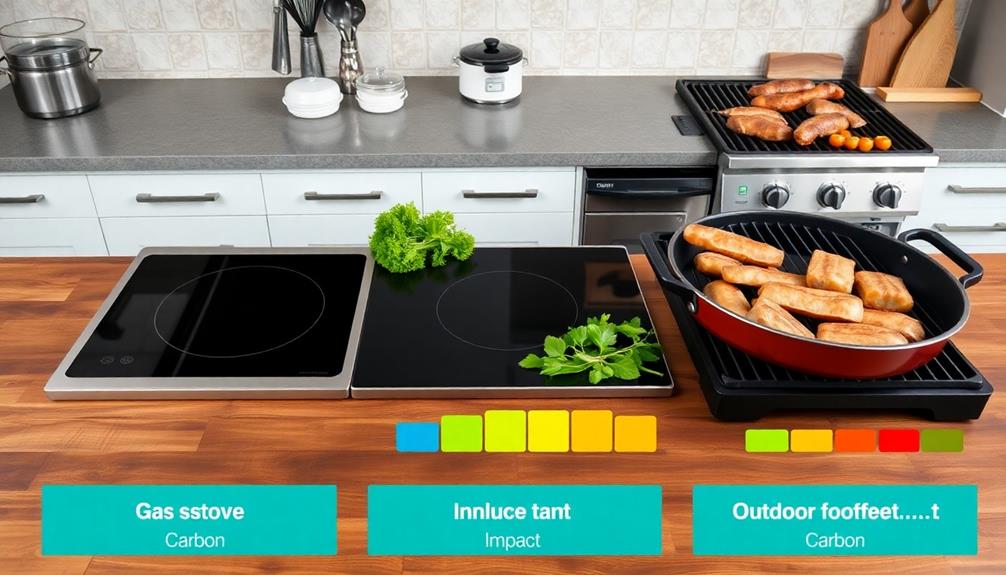The cooking methods you choose can greatly impact the carbon footprint of your meals. For instance, boiling and steaming are more energy-efficient than frying or roasting, leading to lower greenhouse gas emissions. Electric appliances like induction cooktops and microwaves typically use less power compared to gas stoves, which can further reduce your carbon footprint. Using local, seasonal ingredients also helps lower emissions by minimizing transportation requirements. By adopting energy-efficient practices, you not only cut down on energy consumption but can create delicious, sustainable meals. Want to explore more ways to reduce your impact while cooking?
Key Takeaways
- Energy-efficient cooking methods like boiling, steaming, and microwaving significantly reduce greenhouse gas emissions compared to frying or roasting.
- Electric stoves, especially induction cooktops, generally have lower carbon footprints compared to gas stoves due to higher energy efficiency.
- Utilizing local and seasonal ingredients lowers transportation emissions and enhances sustainability in meal preparation.
- Batch cooking and meal planning optimize ingredient use, reducing food waste and minimizing the overall carbon footprint of meals.
- Plant-based foods typically produce fewer greenhouse gases than animal products, making them a more sustainable choice for meals.
Overview of Carbon Footprint in Cooking

When it comes to cooking, the carbon footprint of your meals can vary considerably based on the methods you choose. Different cooking techniques yield different levels of greenhouse gas emissions (GHG emissions). For instance, boiling and steaming are often more energy-efficient and produce lower emissions than frying or roasting.
Choosing local and seasonal ingredients, such as those in a Nettle and Potato Soup, can also enhance sustainability while providing nutritious options. By understanding these cooking methods, you can make more sustainable food choices.
Home cooking contributes greatly to your overall carbon footprint, accounting for 6% to 61% of total emissions for specific foods. It's essential to select energy-efficient appliances; electric stoves generally have lower emissions compared to gas stoves, while induction cooktops lead the pack in efficiency.
Furthermore, using techniques like pressure cooking and slow cooking can greatly reduce energy consumption and GHG emissions.
Plant-based foods typically have a lower carbon footprint than animal products, but the cooking methods you employ can further influence their emissions. By opting for sustainable food practices and mindful cooking techniques, you can effectively contribute to emissions reduction while enjoying delicious, nutritious meals.
Your choices in the kitchen can play a pivotal role in lowering your overall carbon footprint.
Comparison of Cooking Methods

Several cooking methods vary greatly in their environmental impact, affecting your carbon footprint. For instance, traditional Brazilian dishes like Caldeirada, which often require stewing, can be prepared in ways that minimize energy use while maximizing flavor.
When you choose boiling or steaming, you're opting for methods that produce lower GHG emissions compared to frying or roasting. Electric ovens stand out with an energy efficiency of 75.2%, while gas ovens lag at just 41%. This difference means that using electric ovens can help reduce your overall energy consumption and carbon footprint during cooking.
Microwave cooking is another great option; it's generally more energy-efficient than traditional methods, saving electricity and retaining more nutrients in your food.
On the other hand, grilling tends to generate higher emissions due to the use of charcoal or gas, leading to a larger carbon footprint than methods like baking or air frying.
Although slow cooking may take longer, it uses less energy overall, which ultimately results in a reduced carbon footprint compared to faster, more intensive cooking methods.
Energy Efficiency of Appliances

The energy efficiency of cooking appliances plays an essential role in minimizing your carbon footprint. By choosing the right appliances, you can greatly reduce energy consumption and emissions. For instance, electric ovens have an average efficiency of 75.2%, while gas ovens lag behind at only 41%. This means you're likely to save more energy and lower your carbon footprint by using electric options.
Slow cookers, despite longer cooking times, are an energy-efficient choice overall. Air fryers and microwaves also typically consume less power than traditional ovens, leading to considerable energy savings and reduced greenhouse gas emissions. Regular maintenance, like cleaning your ovens and hobs, can further enhance energy efficiency, allowing your appliances to operate at their best and reduce energy usage. Plus, remember that preheating isn't necessary for certain foods, which can save energy and emissions.
Here's a quick comparison of energy efficiency among common cooking appliances:
| Appliance | Energy Efficiency (%) |
|---|---|
| Electric Ovens | 75.2 |
| Gas Ovens | 41 |
| Slow Cookers | Low consumption |
| Air Fryers | Low consumption |
| Microwaves | Low consumption |
Impact of Ingredients on Emissions

When you choose ingredients for your meals, the impact on emissions can be significant.
For instance, traditional dishes like Muamba De Galinha highlight the importance of local ingredients such as chicken and okra, which can have a lower carbon footprint compared to imported products.
Plant-based foods generally produce fewer greenhouse gases than animal products, making them a more sustainable option.
Additionally, sourcing seasonal and local ingredients can further reduce your carbon footprint while supporting the environment.
Plant-Based vs. Animal Products
Choosing what goes on your plate can have a profound impact on the environment, particularly when comparing plant-based foods to animal products. Animal-based foods contribute around twice the greenhouse gas (GHG) emissions compared to their plant-based counterparts. By opting for a plant-based diet, such as enjoying dishes like Mushroom Masala, you can greatly lower your carbon footprint, as these foods generally require less energy for production and result in fewer emissions.
For instance, cultivating legumes and whole grains is far more energy-efficient than raising livestock for meat, which is a resource-intensive process. Additionally, processed animal products usually carry higher emissions due to energy-intensive production and packaging, while whole plant foods typically require less energy to prepare and cook.
Your dietary choices play an important role in sustainability. By prioritizing plant-based ingredients, you not only reduce GHG emissions but also contribute to a more sustainable food system.
Embracing plant-based meals allows you to make a positive impact, enhancing your cooking methods and overall environmental footprint. Making the switch can lead to healthier meals for you and a healthier planet.
Seasonal and Local Ingredients
Fresh tomatoes, harvested in peak summer, not only burst with flavor but also play an essential role in reducing your carbon footprint. By choosing seasonal ingredients, you can considerably lower greenhouse gas emissions. These ingredients are often sourced locally, minimizing transportation distances and the emissions tied to the food supply chain.
For instance, incorporating dishes like Chilaquiles can highlight the use of seasonal produce while celebrating traditional flavors. Supporting local ingredients not only helps the environment but also bolsters regional economies.
Plant-based seasonal foods generally produce lower greenhouse gas emissions compared to animal products, making them key components of a sustainable diet. When you prioritize these ingredients, you enhance the flavor and nutritional value of your meals, making them more appealing and healthier.
Additionally, seasonal produce is likely to be fresher, reducing the risk of food waste in your household.
Sustainable Practices for Home Cooking

Sustainable practices in home cooking not only benefit the environment but also enhance your culinary experience. By adopting certain methods, you can greatly reduce your carbon footprint while enjoying delicious meals.
For instance, preparing dishes like Red-Braised Pork Belly or Sichuan Cold Noodles can be done using energy-efficient techniques that emphasize steaming and boiling.
Here are three effective practices to take into account:
- Opt for Energy-Efficient Cooking Methods: Use boiling, steaming, or microwaving instead of frying or roasting. These methods lower GHG emissions and energy use for cooking, with microwaving being especially effective for retaining nutrients.
- Embrace Batch Cooking: Preparing larger quantities of food minimizes energy consumption per meal. By cooking multiple servings at once, you enhance cooking efficiency and reduce your overall carbon footprint.
- Plan Your Meals & Use Leftovers: Meal planning helps reduce food waste and optimizes energy use during cooking. Properly utilizing leftovers not only saves resources but also guarantees you get the most out of your local ingredients.
Behavioral Changes for Lower Emissions

Making small changes in your cooking habits can lead to significant reductions in carbon emissions. Start by meal planning to optimize ingredient use and minimize food waste, which accounts for about 8-10% of global greenhouse gas emissions.
Cooking in larger quantities or batch cooking enhances energy efficiency, lowering the average energy consumption per meal and reducing overall emissions. For example, utilizing Thanksgiving leftovers for dishes like a Turkey Sandwich or Turkey Soup not only makes the most of your ingredients but also cuts down on additional cooking.
Get creative with leftovers; not only does this minimize waste, but it also cuts down on additional cooking, further lowering your carbon footprint. Choosing seasonal and local ingredients is another impactful step, as it reduces transportation emissions tied to food miles.
Future Trends in Sustainable Cooking

As you adopt more eco-friendly cooking habits, it's exciting to contemplate what the future holds for sustainable cooking. The trends are shifting towards methods and practices that greatly lower the carbon footprint of home cooking. For example, incorporating seasonal ingredients like those found in Candy Corn Fruit Parfaits can enhance both nutrition and sustainability.
Here are three key trends to watch:
- Energy-efficient appliances: Induction cooktops and air fryers are gaining popularity for their ability to reduce GHG emissions associated with traditional cooking methods.
- Plant-based diets: The growing preference for plant-based foods is expected to continue, helping to cut GHG emissions as these diets contribute considerably less to the environmental impacts of food.
- Renewable energy sources: More households are likely to integrate solar or wind power into cooking, enhancing sustainability and further lowering GHG emissions.
In addition, cooking methods like sous-vide and slow cooking will likely rise in popularity due to their energy efficiency and ability to preserve nutrients.
With increased awareness of the environmental impacts of food, you'll find sustainable practices like meal planning and batch cooking becoming essential for reducing food waste. Embracing these trends won't only help you cook better but also contribute to a healthier planet.
Frequently Asked Questions
Does Cooking Increase Carbon Footprint?
Yes, cooking can increase your carbon footprint. The methods you choose and the appliances you use play a significant role in determining the overall emissions. Opting for energy-efficient techniques can help minimize this impact.
Which Method of Cooking Has the Lowest Carbon Footprint?
When you compare cooking methods, boiling and steaming stand out for their energy efficiency, while frying consumes more energy. Opt for microwaving or slow cooking; they considerably lower your carbon footprint without sacrificing taste or nutrition.
How to Reduce Carbon Footprint When Cooking?
To reduce your carbon footprint when cooking, opt for energy-efficient methods like steaming or microwaving, use induction cooktops, batch cook meals, focus on plant-based ingredients, and choose seasonal, local produce to minimize transportation emissions.
What 3 Processes Contribute to the Carbon Footprint of Food?
Did you know nearly one-third of global greenhouse gas emissions come from food systems? The three main processes contributing to this are agriculture, food transportation, and food waste, impacting our environment considerably and requiring your attention.
Conclusion
So, if you thought boiling water was just boiling water, think again! Your cooking methods can make or break your meal's carbon footprint. Who knew that sautéing could be a superhero while boiling lurks in the shadows? Embrace energy-efficient appliances and sustainable ingredients like a true eco-warrior, and you might just save the planet one kale salad at a time. Let's face it, your dinner's carbon footprint should be the only thing that's small!










